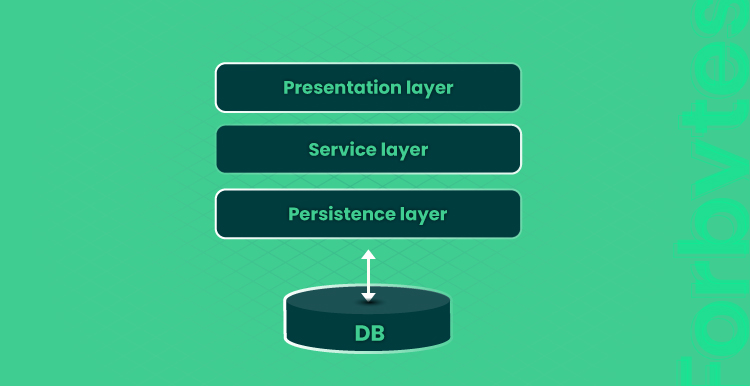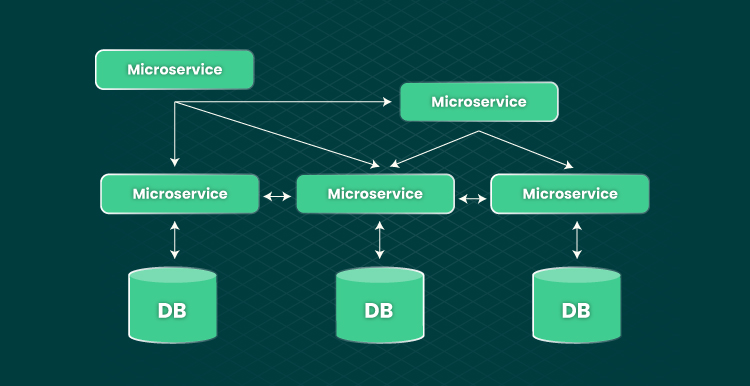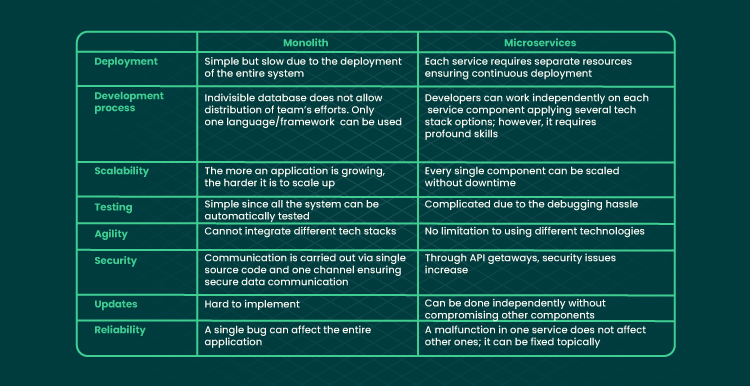When it goes to the underlying architectural style of an application – monolithic vs. microservices, the choice depends on the specific goals of the application and business requirements rather than following trends or competitors’ hallmarks. There is a misconception that businesses have to switch to microservices when they want to profoundly implicate the enterprise as in the case of Netflix, Google, or Spotify. Yes, partly it is a good recommendation; however, each product has its own unique characteristics. The microservice vast adoption is explained by the DevOps approach allowing the creation of scalable and distributed solutions.
Forbytes is here to assist you in selecting the best solution for your product. Let’s dive into architectural comparison outlining their weaknesses and strengths.
What Is a Monolith?
The monolithic approach is a traditional way to create an application as a single and autonomous unit. We can compare it to a single indivisible block, which means the functions are managed in one location. And that, in turn, means that the code base is exposed to excessive space that is impossible to split into separate blocks. And here, it is worth mentioning the uniform layer of monolith consisting of a database, client-side user interface, and server-side application that are interconnected and dependable.
Therefore, monolithic architecture turns out to be the main pain point for developers who cannot make even minor alterations to each function separately and have to deploy updates to the server-side interface. Sounds overwhelming, right? But it does not mean that microservices will be always a good alternative. Keep reading to know whether you need monolith or microservices.

What Are Microservices?
As an opposite alternative to a monolith, microservices require distinctive single-purpose services with their own business logic, codebase, and function. Each module of the microservice-based structure is independent and interacts through API methods. Therefore, each service can be updated and scaled autonomously. With their “independent nature”, microservices allow for greater flexibility and are able to adapt to ever-evolving customer needs. Furthermore, microservices architecture perfectly conforms to the Agile approach (the most popular one involving several software development teams working on small projects individually).

What Is Important While Choosing Between Monolith and Microservices?
In the era of digital transformation and high customer expectations, companies tend to keep pace with new ecommerce trends preventing barriers to revenue generation. To generate value for their customers, businesses need to imply automation to the entire software release pipeline by continuously deploying and delivering changes to customers. With monolithic-based architecture, the timing for software product issuing can be prolonged due to tightly coupled code, which slows down the whole development process. Therefore, it is important to determine the focus of your organization and the demand for the frequency of product releases. However, selecting the right solution depends on a number of determinant factors such as team structure, business goals, budget limits, and the development scope.
The stats show that 77% of organizations have adopted microservices, with 92% experiencing success with microservices. And at the same time, when the adoption of microservices proliferates, there are assumptions that microservices are not to the rescue. Monolith can be easier to develop, and if you do not need advanced scalability, it may be your win-win solution. We are here to debunk myths and some opinions and help you differentiate them by giving you a brief guideline of pros and cons.
Monolith: Drawbacks and Strengths
For monolithic architectures, the benefits are the following:
- Simple development. Being a conventional approach, monolith architecture is mature enough for developers who are not required to possess specific skills as with microservices. Since all functions are unified, it is easier to manage them in one centralized directory.
- Increased performance. Big latency and slow response time hinder the software performance. With a monolith, the communication is performed within a single local service via one API request, which impacts the streamlining of the processing time.
- Easy testing and debugging. There is no need to test each separate unit since with a single database, automated testing is worth the weight of gold to make it promptly.
And conversely, monolithic architecture, with its strengths, comes at the risk of scaling and upgrading due to the lack of flexibility. Let’s see the downsides:
- Hard to scale. The software components cannot be scaled and upgraded independently because of the tight coupling and the need to use a whole stack. Therefore, to implement even a small change, developers have to redeploy the whole application, leading to greater time consumption.
- Lack of flexibility. To add new technology, developers need to restructure the whole application.
- Single point of failure. Monolithic architectures function as a centralized space where small units are coupled and connected, which means that in case of the malfunction of one part, the entire system is doomed for failure.
- Hard to manage. A single-unit database of monolithic architectures affects the effective distribution of team efforts since it is indivisible. In order to completely grasp the business logic, developers need to break the application into blocks, which is not inherent to a monolithic approach.
Microservices: Pros and Cons
With microservices consisting of modular components, businesses get empowered with solid agility and eCommerce enrichment. Let’s see what advantages of microservices foster software development:
- Agility. With Agile methodology, the application functionality is split into separate chunks. You do not need to adhere to one technology since microservices allow applying different technology stacks for different functions. Such a benefit accelerates software development processes and enhances the achievement of business goals in the long run.
- Increased scalability. Being a self-contained module, a microservice can be updated independently without the need to reorganize the system. Therefore, it is a cost and time-effective solution for the application to scale up. Horizontal scaling of microservices enables alterations only for a particular function. Moreover, involving more team members does not affect the workload since each team member works on separate services.
- Resilience. In the case of damage or malfunction, the whole system remains invulnerable.
- Easy to manage. Each developer is focused on the specific component they are assigned to. With distributed services, it is easier to onboard the developers and understand the architecture, resulting in faster time-to-market.
Though the microservice approach does not restrict the development process scope and allows for integrating various technologies, it still has its drawbacks:
- Complex deployment. With the multitude of distributed counterparts (even if they are lightweight, scalable, and easy to develop) and due to hundreds of API requests and interactions between the separate units, there is the chance of delays that can impair application performance.
- Testing and debugging challenges. To detect error sources, developers have to screen through each service log separately, taking into consideration the need for microservices interaction. Therefore, there is a big chance of hassle with debugging due to the difficulties in fault isolation.
- More security threats. The more standalone services an application has, the bigger the number of exposed access points that need to be put under rigorous control.

So, How Do These Architectures Impact Products?
While selecting the appropriate architecture for your product, it is essential to estimate the impact on the product delivery. Answering the following questions will guide you in the right direction:
- How will an application be presented to your users when there are any updates or alterations?
- How much time the development and deployment will take, and how much effort will it take to perform the development process?
- Are there any risks of product failure?
- Is it important for your users to ensure continuous delivery?
Analyzing all the answers mentioned above, you can determine the impact of each solution on your product.
For example, with monolithic single-based architecture and components hosted in one directory, the delivery is streamlined. For microservices, testing is a weak area since if there are too many points of failure, the whole system needs to be scanned from scratch. Also, as mentioned before, the scalability issue is the main barrier for large organizations that look for a solution allowing them to easily and effectively expand their business. Therefore, eCommerce businesses tend to apply microservices, which opens new avenues for smooth growth and quick adaptation to market demands. By that, we mean microservices enable developers to implement front-end updates and provide swift delivery of services without compromising other essential components which can affect user experience. A good example is Uber’s leveling up its growth strategy by moving to microservices from a monolith. With each microservice performing individual functionality, there is now no need to intervene in all the services. If anything is changed, for instance, in Driver management, there is no reason to update the Passenger management microservice.
Middle-sized teams can benefit from monolith architectures prioritizing easy development, testing, and debugging. But even for large enterprises, microservices may turn out to make less sense. Here is the list of the monolithic open-source projects on GitHub, among which is Facebook. Instead of switching from monolith to microservices, Facebook decided to scale its PHP monolith to move fast without time-consuming code refactoring.

Microservices vs. Monolith: Which One to Select?
When to Use Monolith?
If your application is small and its primary concern is simplicity and fast development – monolith is your road forward. Microservices’ advocates prove the efficacy of microservice-based architecture only for complex projects. Even if you are likely to scale up your product and are certain about the benefits microservices can bring in the long run, start with a monolith-first strategy, experts recommend. Yes, if you are not planning to evolve your product – that way, the monolith is your perfect fit. Moreover, the best way to know if your product idea is valuable is to create a simplistic version.
If you need fast iterations and quick feedback from your first users, implying a monolithic approach to your minimum viable product will be a good idea.
With a monolith-first strategy, you can shift to microservices by figuring out the right boundaries between the services. This is the primary premise of architecture migration since refactoring functionality between services can be a challenge. With a monolith, you get the opportunity to streamline your time-to-market terms even if you are going to discard and switch to microservices.
When to Use Microservices?
By starting with microservices, you have to consider hiring several software development teams from the very beginning, focusing on each service (function). But to deliver a holistic outcome, they still have to be involved in cross-communication. For complex projects with a variety of components, features, and modules, it’s better to go for a microservice-based architecture.
So What to Choose?
Before making the final decision, there are factors worth considering:
- Organization infrastructure. If you want to deploy only one database server, the monolith will be an easy and fast solution without involving cross-technology team members. For microservices implementation, the scope of work encompasses setting up a standalone database for every single microservice. For this purpose, you need to hire a tech-savvy team and estimate the current situation with your infrastructure. Has your organization adopted Agile technology? Do you follow the manual or automated testing? Does your organization have on-premise software, or is it moving to a cloud-based environment?
- Team maturity. Evaluate your team size and capabilities. For microservices architecture, you have to adhere to a full-fledged all-around approach following Agile methodology. The team should be mature enough and efficient to manage separate microservice components. Mind that each team member must possess sufficient skills and knowledge to run each microservice independently.
- Budget limitation. This factor is crucial since in terms of resources, infrastructure type, and team expertise, microservice is cost-intensive compared to the monolith. Many businesses think their project will be the next unicorn and are ready to invest large sums into the bubble concepts through hyper-scalable infrastructures. Methodological approaches, proper estimation of possibilities and risks, and understanding of business goals are the determinant criteria when adjusting your budget.
Final Word
So, what solution will best suit your product? Monolith architecture can be your most optimal option if you have a small application or want to build an MVP. But if your aim is continuously updating and scaling without compromising front-end components for your users, in this case, microservices can bring you enormous benefits (if you have estimated all the risks, budget, and available resources).
Anyway, if you are still not sure what solution to choose, our team at Forbytes can help you with it.

Our Engineers
Can Help
Are you ready to discover all benefits of running a business in the digital era?

Our Engineers
Can Help
Are you ready to discover all benefits of running a business in the digital era?







